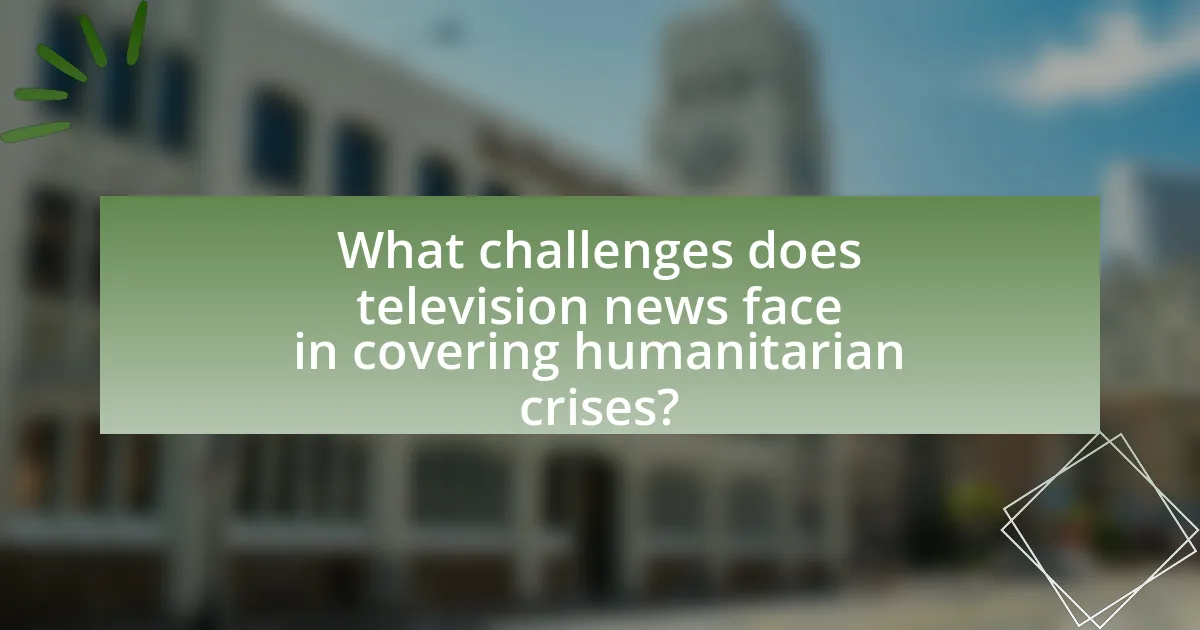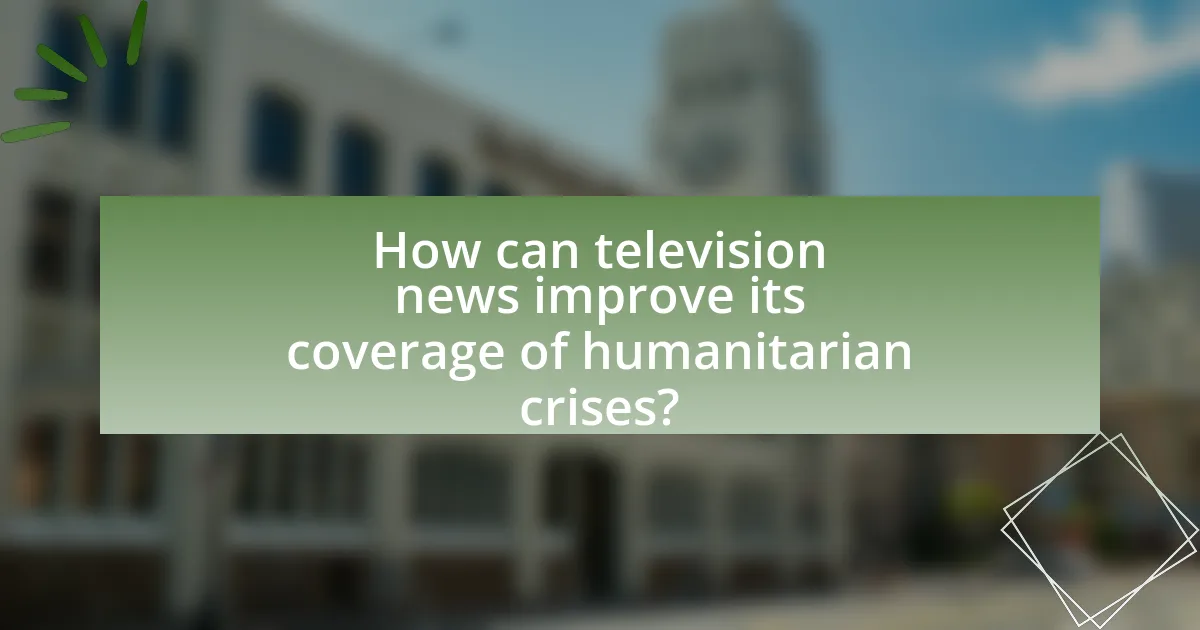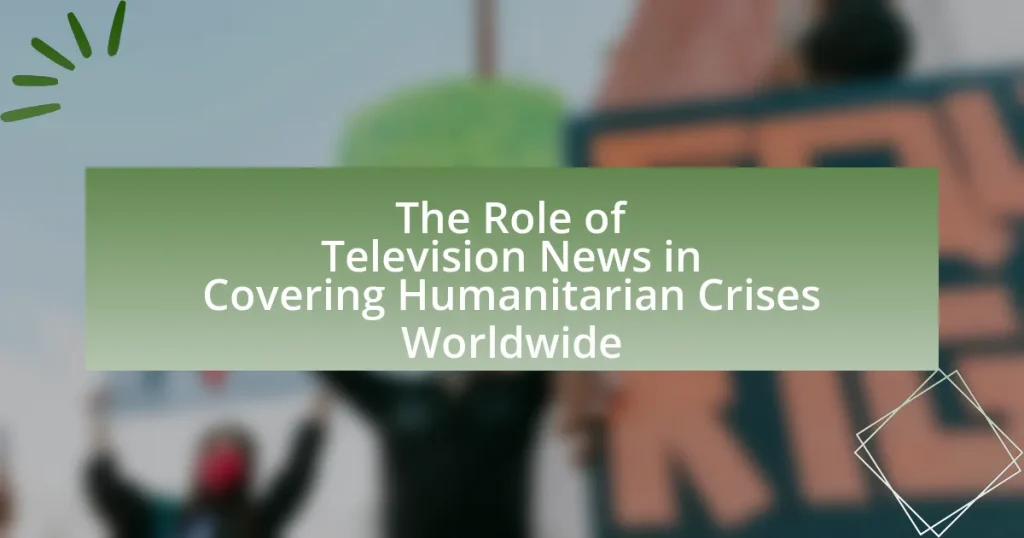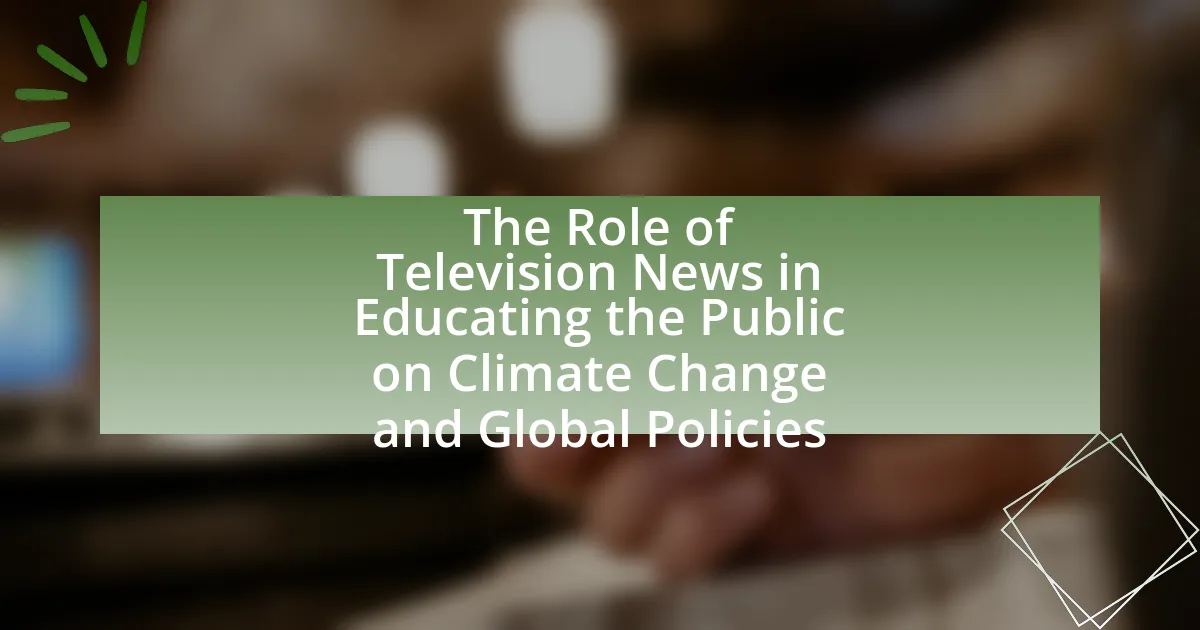Television news serves a vital role in covering humanitarian crises worldwide by providing timely information, raising awareness, and mobilizing public support. The article examines how television news reports on these crises through real-time coverage, interviews, and expert analysis, emphasizing the importance of accuracy, sensitivity, and context in effective reporting. It also discusses the challenges faced by journalists, including access issues, sensationalism, and the risks encountered in conflict zones. Furthermore, the article highlights the impact of television news on public awareness and humanitarian aid responses, as well as the potential for technological advancements and audience engagement to enhance future coverage.

What is the role of television news in covering humanitarian crises worldwide?
Television news plays a critical role in covering humanitarian crises worldwide by providing timely information, raising awareness, and mobilizing public support. Through live broadcasts and reports, television news outlets can quickly disseminate information about ongoing crises, such as natural disasters or conflicts, allowing viewers to understand the severity and urgency of the situation. For instance, during the 2010 Haiti earthquake, television coverage significantly increased international aid and support, with reports highlighting the immediate needs of affected populations. This demonstrates that television news not only informs the public but also influences humanitarian responses and policy decisions by showcasing the human impact of crises.
How does television news report on humanitarian crises?
Television news reports on humanitarian crises by providing real-time coverage, interviews with affected individuals, and expert analysis. This reporting often includes visual imagery that highlights the severity of the situation, such as footage of displaced populations or destruction. For instance, during the Syrian refugee crisis, networks like CNN and BBC broadcasted live reports from border regions, showcasing the plight of refugees and the response from humanitarian organizations. Such coverage aims to raise awareness and mobilize public support, evidenced by increased donations to relief efforts following extensive media exposure.
What are the key elements of effective reporting in humanitarian crises?
The key elements of effective reporting in humanitarian crises include accuracy, timeliness, sensitivity, and context. Accuracy ensures that the information presented is factual and reliable, which is crucial in maintaining credibility during crises. Timeliness refers to the need for rapid dissemination of information to inform and mobilize aid efforts effectively. Sensitivity involves understanding the emotional and cultural contexts of affected populations, ensuring that reporting does not exploit their suffering. Context provides background information that helps audiences understand the complexities of the crisis, including historical, political, and social factors. These elements collectively enhance the quality and impact of reporting in humanitarian situations, as evidenced by the role of organizations like the International Federation of Red Cross and Red Crescent Societies, which emphasizes the importance of accurate and timely information in disaster response.
How do journalists gather information during crises?
Journalists gather information during crises primarily through direct observation, interviews, and leveraging technology. They often report from the ground, observing events firsthand to provide accurate accounts. Additionally, journalists conduct interviews with affected individuals, officials, and experts to gain diverse perspectives and insights. Technology plays a crucial role, as journalists utilize social media platforms for real-time updates and crowd-sourced information, which can enhance their reporting. For instance, during the 2010 Haiti earthquake, journalists relied heavily on social media to gather information quickly and disseminate news to a global audience.
Why is television news important in the context of humanitarian crises?
Television news is important in the context of humanitarian crises because it serves as a critical platform for raising awareness and mobilizing support. By broadcasting real-time coverage of events, television news informs the public about the severity and urgency of crises, such as natural disasters or conflicts, which can lead to increased humanitarian aid and intervention. For instance, during the 2010 Haiti earthquake, extensive television coverage played a significant role in generating international donations, with reports indicating that over $1 billion was raised within weeks due to heightened visibility of the disaster. This demonstrates how television news not only disseminates information but also catalyzes action and fosters global solidarity in times of need.
What impact does television news have on public awareness of humanitarian issues?
Television news significantly enhances public awareness of humanitarian issues by providing immediate access to information and visual narratives that evoke emotional responses. Research indicates that televised reports on crises, such as natural disasters or conflicts, can lead to increased public engagement and donations; for instance, a study by the Pew Research Center found that 63% of Americans reported being more likely to donate to humanitarian causes after seeing news coverage of those issues. Furthermore, the visual nature of television allows viewers to witness the realities of suffering, which can foster empathy and a sense of urgency, prompting action and advocacy.
How does television news influence humanitarian aid responses?
Television news significantly influences humanitarian aid responses by shaping public perception and mobilizing support for crises. When major disasters or humanitarian issues are broadcasted, they often lead to increased awareness and urgency among viewers, prompting them to donate or advocate for aid. For instance, the coverage of the 2010 Haiti earthquake resulted in over $1.4 billion in donations within a few weeks, demonstrating how televised reports can directly impact funding and resources allocated to humanitarian efforts. Furthermore, television news can pressure governments and organizations to act swiftly, as seen in the international response to the Syrian refugee crisis, where extensive media coverage highlighted the plight of displaced individuals, leading to increased aid commitments from various countries.

What challenges does television news face in covering humanitarian crises?
Television news faces significant challenges in covering humanitarian crises, primarily due to issues of access, sensationalism, and resource limitations. Access to affected areas can be restricted by conflict, government regulations, or safety concerns, which hampers journalists’ ability to report accurately. Sensationalism often arises as networks prioritize dramatic visuals over nuanced storytelling, potentially misrepresenting the complexities of the situation. Additionally, limited resources, including funding and personnel, can restrict the depth and breadth of coverage, leading to incomplete narratives. These challenges hinder the ability of television news to provide comprehensive and responsible reporting on humanitarian crises.
How do logistical issues affect news coverage in crisis zones?
Logistical issues significantly hinder news coverage in crisis zones by limiting access to affected areas, delaying the delivery of equipment and personnel, and complicating communication. For instance, natural disasters or armed conflicts often damage infrastructure, making it difficult for journalists to reach the scene and report timely updates. According to a report by the International Federation of Journalists, 70% of journalists in crisis situations cite transportation challenges as a primary barrier to effective reporting. Additionally, the lack of reliable power sources and internet connectivity can impede the ability to transmit news, resulting in delayed or incomplete coverage of critical events.
What are the risks journalists encounter while reporting from conflict areas?
Journalists encounter multiple risks while reporting from conflict areas, including physical harm, psychological trauma, and legal repercussions. Physical harm can arise from exposure to violence, such as gunfire or bombings, with reports indicating that over 1,300 journalists have been killed in conflict zones since 1992, according to the Committee to Protect Journalists. Psychological trauma is prevalent due to the stress of witnessing violence and suffering, leading to long-term mental health issues. Additionally, journalists may face legal risks, including arrest or detention by authorities who may view them as threats or adversaries, as seen in various countries where press freedom is restricted. These risks highlight the dangerous environment in which journalists operate while striving to inform the public about humanitarian crises.
How do censorship and government restrictions impact coverage?
Censorship and government restrictions significantly limit coverage by controlling the flow of information and shaping narratives. These limitations often result in the suppression of critical news about humanitarian crises, leading to a lack of transparency and public awareness. For instance, in countries with strict media controls, such as North Korea, independent reporting on humanitarian issues is virtually nonexistent, which skews public perception and hinders international response efforts. Furthermore, studies indicate that media outlets operating under government restrictions may prioritize state-approved narratives, thereby undermining journalistic integrity and the diversity of viewpoints essential for comprehensive coverage.
What ethical considerations must journalists keep in mind?
Journalists must prioritize accuracy, fairness, and integrity in their reporting. Accuracy ensures that information is correct and verified, which is crucial in maintaining public trust and preventing misinformation, especially during humanitarian crises. Fairness involves presenting multiple perspectives and avoiding bias, which is essential for a balanced portrayal of events. Integrity requires journalists to adhere to ethical standards, such as avoiding conflicts of interest and respecting the dignity of individuals affected by crises. These considerations are vital for responsible journalism, as they uphold the profession’s credibility and contribute to informed public discourse.
How do journalists balance sensationalism with responsible reporting?
Journalists balance sensationalism with responsible reporting by adhering to ethical guidelines and prioritizing factual accuracy. They strive to present stories that engage audiences without exaggerating or distorting the truth. For instance, the Society of Professional Journalists emphasizes the importance of minimizing harm and seeking truth, which guides journalists in their reporting practices. By fact-checking information and providing context, journalists can report on humanitarian crises effectively while avoiding sensationalist narratives that may mislead the public. This approach not only maintains credibility but also fosters informed public discourse on critical issues.
What role does accuracy play in reporting humanitarian crises?
Accuracy is crucial in reporting humanitarian crises as it ensures the dissemination of reliable information that can influence aid responses and public perception. Accurate reporting helps humanitarian organizations assess needs effectively, allocate resources appropriately, and mobilize support from governments and the public. For instance, the United Nations Office for the Coordination of Humanitarian Affairs emphasizes that precise data on the scale and nature of crises is essential for effective intervention and resource distribution. Misinformation can lead to inadequate responses, misallocation of resources, and can even exacerbate the suffering of affected populations. Thus, accuracy in reporting directly impacts the effectiveness of humanitarian efforts and the overall outcome for those in crisis.

How can television news improve its coverage of humanitarian crises?
Television news can improve its coverage of humanitarian crises by prioritizing in-depth reporting and providing context about the affected regions. This approach allows audiences to understand the complexities of the crises, rather than just presenting surface-level information. For instance, in the coverage of the Syrian refugee crisis, networks that included personal stories and historical context helped viewers grasp the ongoing challenges faced by displaced individuals. Research from the Pew Research Center indicates that audiences are more engaged with stories that offer comprehensive insights, leading to increased awareness and support for humanitarian efforts. By focusing on these elements, television news can enhance its role in informing the public and fostering a more empathetic response to humanitarian issues.
What best practices should journalists follow when reporting on crises?
Journalists should prioritize accuracy, empathy, and context when reporting on crises. Accuracy ensures that information is verified and reliable, which is crucial in high-stakes situations where misinformation can exacerbate harm. Empathy involves understanding the human impact of crises, allowing journalists to portray affected individuals and communities with dignity and respect. Context is essential for helping audiences grasp the complexities of the situation, including historical, social, and political factors that contribute to the crisis. For instance, the International Federation of Journalists emphasizes the importance of ethical reporting standards, which include verifying facts and avoiding sensationalism, to maintain public trust and provide meaningful coverage.
How can collaboration with NGOs enhance news coverage?
Collaboration with NGOs can enhance news coverage by providing journalists with access to on-the-ground information, expert insights, and resources that improve the accuracy and depth of reporting. NGOs often have established networks and local knowledge that can help media outlets uncover stories that may otherwise go unreported, particularly in humanitarian crises. For instance, during the Syrian refugee crisis, partnerships between news organizations and NGOs like the International Rescue Committee facilitated comprehensive coverage of the challenges faced by displaced populations, leading to increased public awareness and advocacy. This collaboration not only enriches the narrative but also ensures that critical issues are highlighted, fostering a more informed audience.
What training do journalists need to effectively cover humanitarian issues?
Journalists need specialized training in humanitarian reporting to effectively cover humanitarian issues. This training should include understanding the complexities of humanitarian crises, ethical reporting practices, cultural sensitivity, and the ability to communicate effectively with affected populations. Additionally, journalists should be trained in risk assessment and safety protocols to protect themselves and their sources in volatile environments. Evidence of the importance of this training can be seen in the increased accuracy and sensitivity of reporting in crises where journalists have undergone such training, leading to better public awareness and response.
What technological advancements can aid in crisis reporting?
Technological advancements that can aid in crisis reporting include real-time data analytics, mobile reporting applications, and satellite imagery. Real-time data analytics allows journalists to process and interpret large volumes of information quickly, enabling them to report on evolving situations more effectively. Mobile reporting applications empower reporters to capture and disseminate news from remote locations, enhancing coverage during crises. Satellite imagery provides critical visual data that can help assess damage and coordinate relief efforts, as demonstrated during natural disasters like Hurricane Katrina, where satellite technology played a key role in situational awareness and response planning.
How can social media be leveraged to enhance television news coverage?
Social media can be leveraged to enhance television news coverage by providing real-time updates and facilitating audience engagement. Television news outlets can utilize platforms like Twitter and Facebook to gather immediate information from eyewitnesses during humanitarian crises, which can lead to more timely and accurate reporting. For instance, during the 2010 Haiti earthquake, social media played a crucial role in disseminating information quickly, allowing news organizations to report on the ground realities almost instantaneously. Additionally, social media enables news channels to interact with viewers, encouraging them to share their experiences and insights, which can enrich the narrative and provide diverse perspectives on the crisis. This integration of social media not only enhances the depth of coverage but also fosters a sense of community and shared experience among viewers.
What role does data journalism play in reporting humanitarian crises?
Data journalism plays a crucial role in reporting humanitarian crises by providing evidence-based insights that enhance the understanding of complex situations. It utilizes quantitative data to highlight the scale and impact of crises, such as the number of displaced individuals or the prevalence of diseases, thereby informing both the public and policymakers. For instance, during the Syrian refugee crisis, data journalism revealed that over 6.6 million Syrians were displaced internally, which helped to shape international responses and aid efforts. By visualizing data through infographics and interactive maps, data journalism makes the information more accessible and compelling, driving engagement and action.
What are the future trends in television news coverage of humanitarian crises?
Future trends in television news coverage of humanitarian crises include increased use of real-time reporting, integration of social media, and enhanced audience engagement through interactive content. Real-time reporting allows news outlets to provide immediate updates during crises, which is crucial for informing the public and mobilizing support. The integration of social media platforms enables journalists to gather firsthand accounts and visuals from affected individuals, enriching the narrative and providing diverse perspectives. Enhanced audience engagement through interactive content, such as live Q&A sessions and virtual reality experiences, fosters a deeper connection between viewers and the humanitarian issues being reported. These trends reflect the evolving landscape of media consumption and the need for more dynamic and responsive coverage in the face of global crises.
How might audience engagement shape the future of crisis reporting?
Audience engagement will significantly shape the future of crisis reporting by driving the demand for real-time, interactive, and personalized news coverage. As audiences increasingly utilize social media and digital platforms to share their experiences and perspectives during crises, news organizations are compelled to adapt their reporting strategies to incorporate user-generated content and feedback. This shift is evidenced by the rise of platforms like Twitter and Facebook, where real-time updates and community-driven narratives have become essential for comprehensive crisis coverage. Furthermore, studies indicate that audience participation can enhance the credibility and relevance of news stories, as seen in the 2011 Arab Spring, where citizen journalism played a crucial role in shaping global perceptions of the events. Thus, the integration of audience engagement into crisis reporting not only enriches the narrative but also fosters a more informed and active public.
What innovations are emerging in the field of humanitarian journalism?
Innovations emerging in the field of humanitarian journalism include the use of mobile technology, data journalism, and immersive storytelling techniques such as virtual reality. Mobile technology enables journalists to report from remote locations quickly, while data journalism allows for the analysis of large datasets to uncover trends and inform narratives about humanitarian crises. Immersive storytelling, particularly through virtual reality, provides audiences with a more engaging and empathetic understanding of the situations faced by affected populations, enhancing the impact of the reporting. These innovations are reshaping how humanitarian issues are covered and perceived globally.




